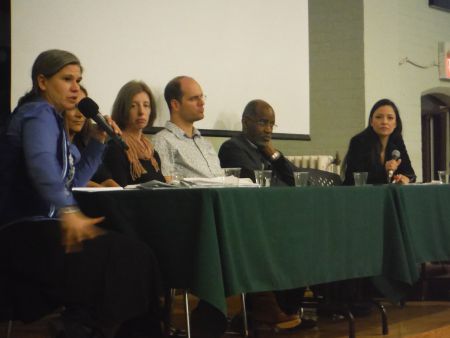Despite the cold and snow, people packed the Native Canadian Centre's auditorium on the evening of February 3rd. As the muted sounds of drumming vibrated up through the auditorium floor, people eat venison stew and fry bread, chatted with each other and prepared to discuss the issues raised in a new report called First Peoples, Second Class Treatment: The role of racism in the health and well-being of Indigenous peoples in Canada.
A joint effort between the Living Well Centre of St. Michael's Hospital, the Centre for Research on Inner City Health (CRICH), The Wellesley Institute, and Dalla Lana School of Public Health, the First Peoples’ report sought to answer the question; What are the fundamental ways in which racism is responsible for the alarming disparities in health between Indigenous and non-Indigenous people?
The events attendees, made up of equal parts university students, older academics and Native youth and elders, agreed that racism, as a product of colonization, is a very real problem in Canada. This is despite the outward portrayal of Canada as an inclusive, multicultural nation. While pinpointing exactly how it is manifest can pose a challenge, merely acknowledging that racism is a factor which inhibits the equal distribution of services is crucially important.
To provide an international perspective, the report’s co-authors, Dr. Janet Smylie, a Metis physician at St. Michael's hospital and director of the Well Living House and Dr. Billie Allan a Postdoctoral Fellow and Research Associate at the Well Living House and the Centre for Research on Inner City Health, were joined by four visiting academics.
Dr. Yin Paradies from Australia explained how racism can be difficult to study as the effects may be unseen or subtle.
However, Dr. David R. Williams of the U.S explained the need for researchers to push their work further as the few studies that have been completed on the subject show that racism has a greater impact than class in its effect on health.
Dr. Williams also acknowledged how researchers frequently encounter resistance from funding bodies and government officials when their work is explicitly on racism. He explained the game of renaming reports or conferences to appease these powers, while maintaining the substantive content of the work.
Doctors Ricci Harris and Donna Cormack from New Zealand completed the panel. Dr Harris made the distinction that as a physician and researcher, it is essential not to individualize behavior, but to see the overarching effect of racism as one of the important determinants of people’s health.
The event was organized as more of a community meeting than panel discussion among these experts. Many questions, comments and experiences were shared by the assembled group. Although time was limited, the organizers made sure to acknowledged that the community is full of ‘experts’ who live this reality daily and that any research of this sort must foreground the lived experiences of those who had historically been treated as mere subjects.
When a community member asked how to get the pervasiveness of racism onto the political agenda in hopes of mandating real change, Dr. Smiley pointed to the consciousness raising of Idle No More. She explained that after the continued pressure from the movement and actions of Chief Theresa Spence, social service organizations and funding bodies realized there was a need for more work to be done. That realization made it easier for her to launch the First Peoples project.
Dr. Smiley’s observation underscores the importance of sustained political pressure from grassroots movements. Not only has Idle No More help put Native demands in the mainstream media, by opening a window of opportunity for funding research projects, the movement is having a ‘trickle-up’ affect into the world of academia and policy advisory.
The full report can be found on the Wellseley Institute’s website here and a summary version here.

